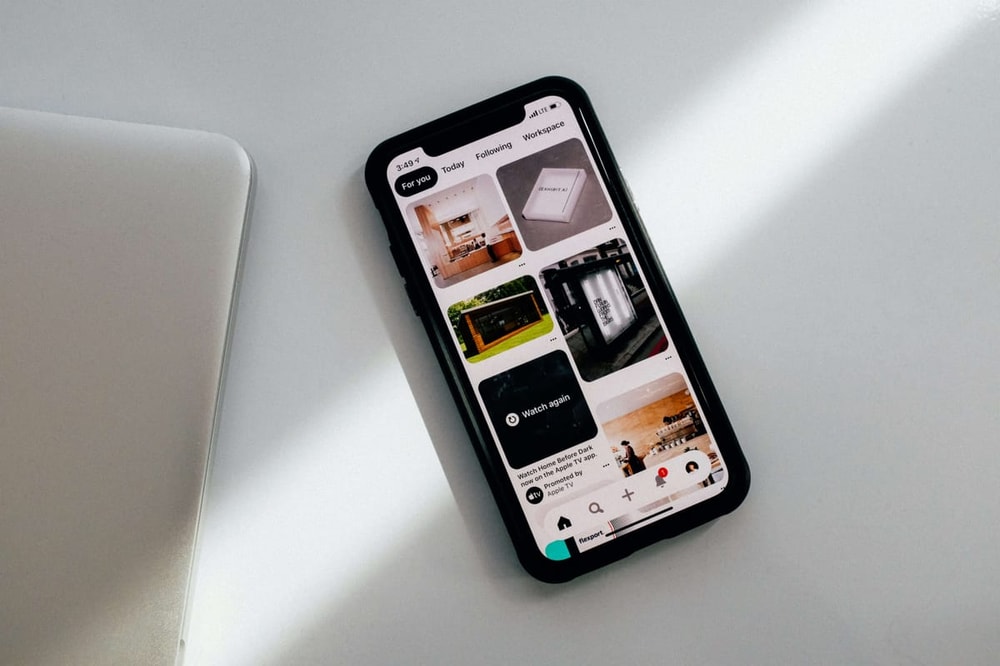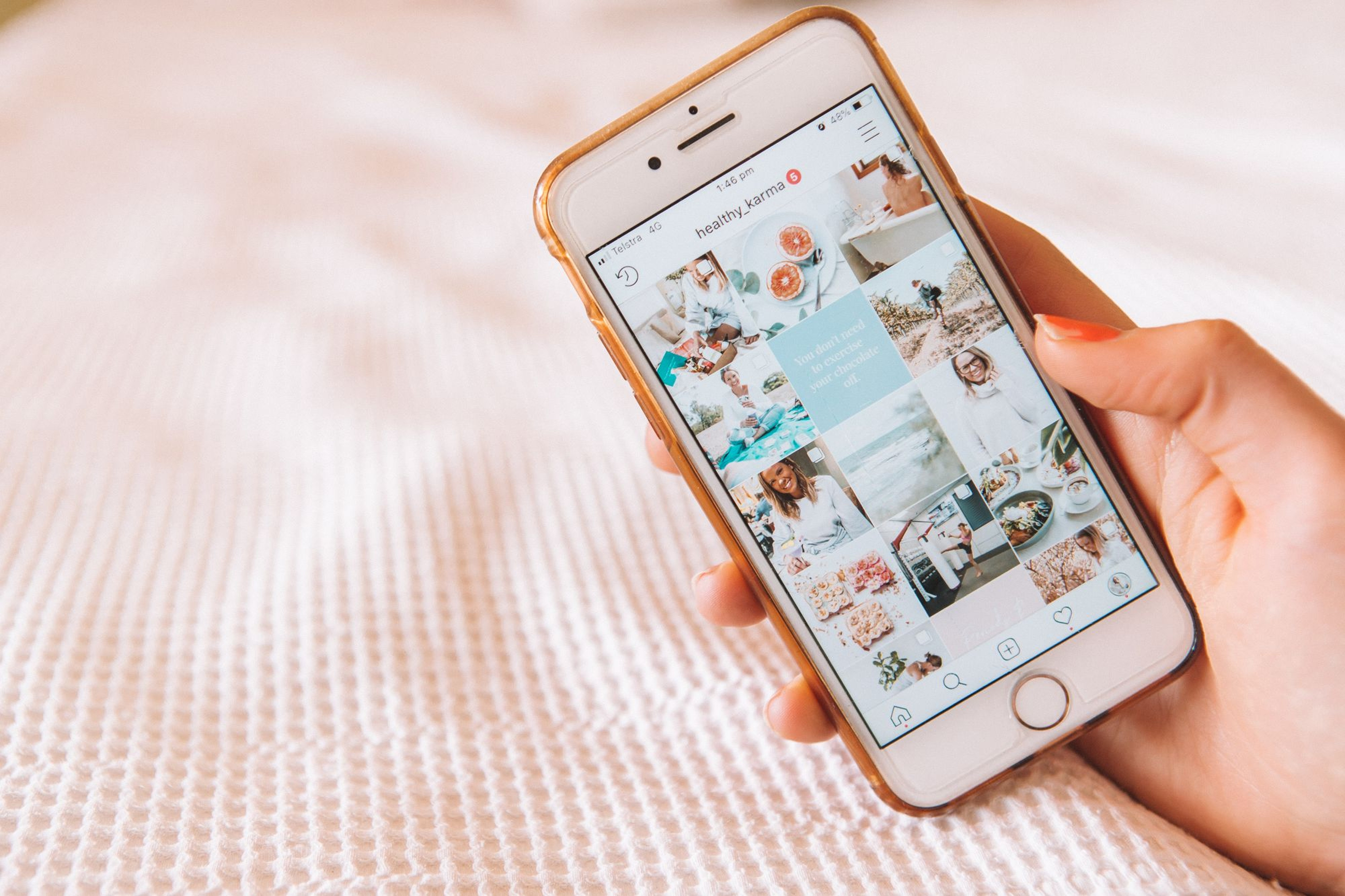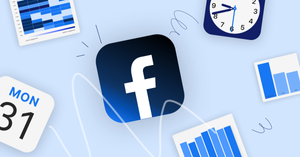Pinterest has what many other social media sites don’t: The ability to insert your website’s link in every post. While Instagram and TikTok are stingy with their limited “link in bio” features, Pinterest is all about helping your business thrive by redirecting people to your website.
What’s more: Pinterest is the sweet combo of a social media platform and a visual search engine. People come here to scroll for inspiration and search like they’d on Google.
Getting more followers on Pinterest translates to a generous outbound spike in website traffic and a direct positive impact on your business. The problem? Growing on Pinterest is harder than ever. Here are 20 tips that’ll help you move the needle right away.
1: Convert your Pinterest profile to a Business account
Pinterest has two kinds of accounts: Personal and Business. If you have a Personal account, I’d recommend switching to Business. Why? Because Business accounts have access to:
- Analytics for how your pins are performing
- Advertising features to create various types of ads
- Pinterest Business Hub & Creator Hub
Pinterest itself recommends converting to a Business account to access helpful growth features. Here’s how you can convert your Pinterest personal account to a Business profile:
1. Log in to your Pinterest account
2. Click the arrow next to your profile icon
3. Click on the “Convert to Business” option and upgrade for free
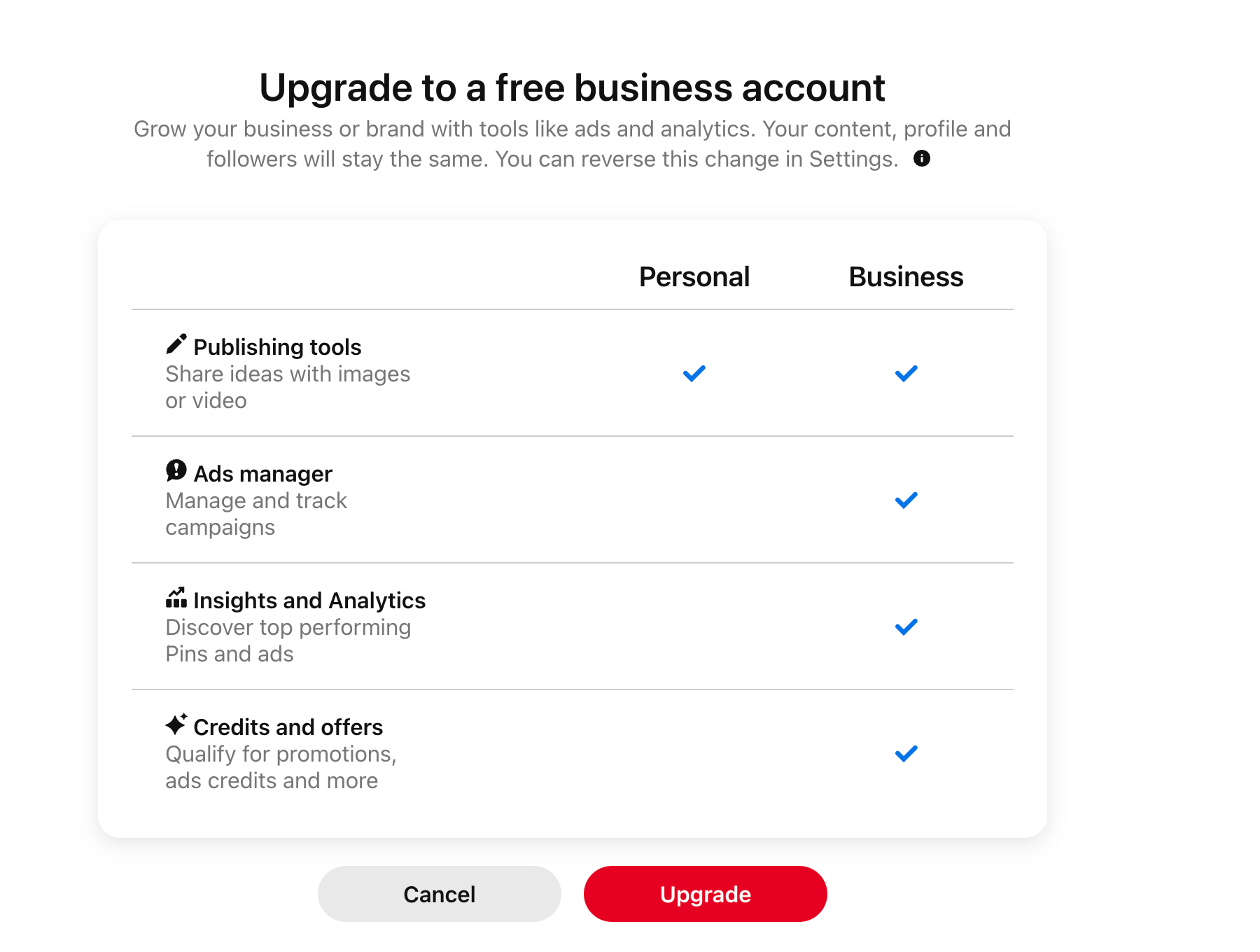
2: Brand your Pinterest profile to make it recognizable
Optimizing your profile is the prerequisite for growing on Pinterest. Imagine someone clicking on your pin, going to your Pinterest profile to learn more, and having no clue who you are or what you do. They won’t hit that follow button.
Here’s how to give some personality to your Pinterest profile page:
1. Add your name and profile name to your profile. If you have a brand name or username that you’re already using on your website and other social media accounts, use the same one here.
2. Add a clear profile photo so people can put a face to your name. If you’re a brand, put your logo in the profile photo.
3. Use your “About” section to describe what you post on Pinterest and how it can benefit your audience. Keep it short and sweet.
4. Add a cover photo telling people what you do or what you represent. This isn’t necessary, but it’s a good addition!
⚡ Pro-tip: Pinterest also recommends adding searchable keywords in conjunction with your name to make it easy for people to discover you.
Shreya Dalela, creator of The Creatives Hour, is the perfect example of how you can brand your account and make it easy for people to click follow.

If you’re a small business, you can also apply for Pinterest’s verified merchant program to get a blue checkmark, which gives you that extra badge of authenticity and some coveted features (like shopping experiences).
And remember: Branding isn’t just for your profile. Pinterest actively encourages its users to put a logo on every pin they share:
“Put a logo on every Pin that you make, but keep it subtle. Avoid the lower-right corner, since that spot gets covered up by our product icons.”
3: Verify your website
While you’re in the branding section, Pinterest also gives you the option to claim your website. This ensures that your profile picture always appears alongside your pin and every other pin Pinterest users save from your website. And whenever someone sees your profile picture, they can check out your Pinterest account and follow you.
Claiming your website also helps you understand what viewers are pinning from your site by giving you access to advanced analytics.
How do you claim your website? You have to add an HTML or TXT code to your website. It sounds more complicated than it is. This video shows you how to do it step-by-step.
Verifying your website also enables you to create rich pins. What are rich pins? They are a type of pin that automatically sync information from your website. So, if you update an article on your website, the rich pin you’ve created for it will automatically update with the new information. Rich pins also show more data on your pins compared to other pins, like titles and pin descriptions.
4: Create fresh pins consistently
All social networks want you to post consistently on their platform. The ideal frequency for Pinterest is at least one pin a week. However, Tailwind’s study has found that its most successful Pinterest users pin 15 – 20 times a day.
Pinterest says there are five types of content styles you can create:
1. Instructional
2. Quick tip
3. Comparison
4. Storyteller
5. Conversation
For example, Lindsey Baruch creates a ton of step-by-step guide style Pinterest content because it suits her niche of creating recipes for her followers.

Short-form video content is the best way to present tutorials and how-to content.
On the other hand, Isabelle Dias creates instructional and quick tip Pinterest content in the form of infographics, still visuals, etc., because it suits her self-development niche.
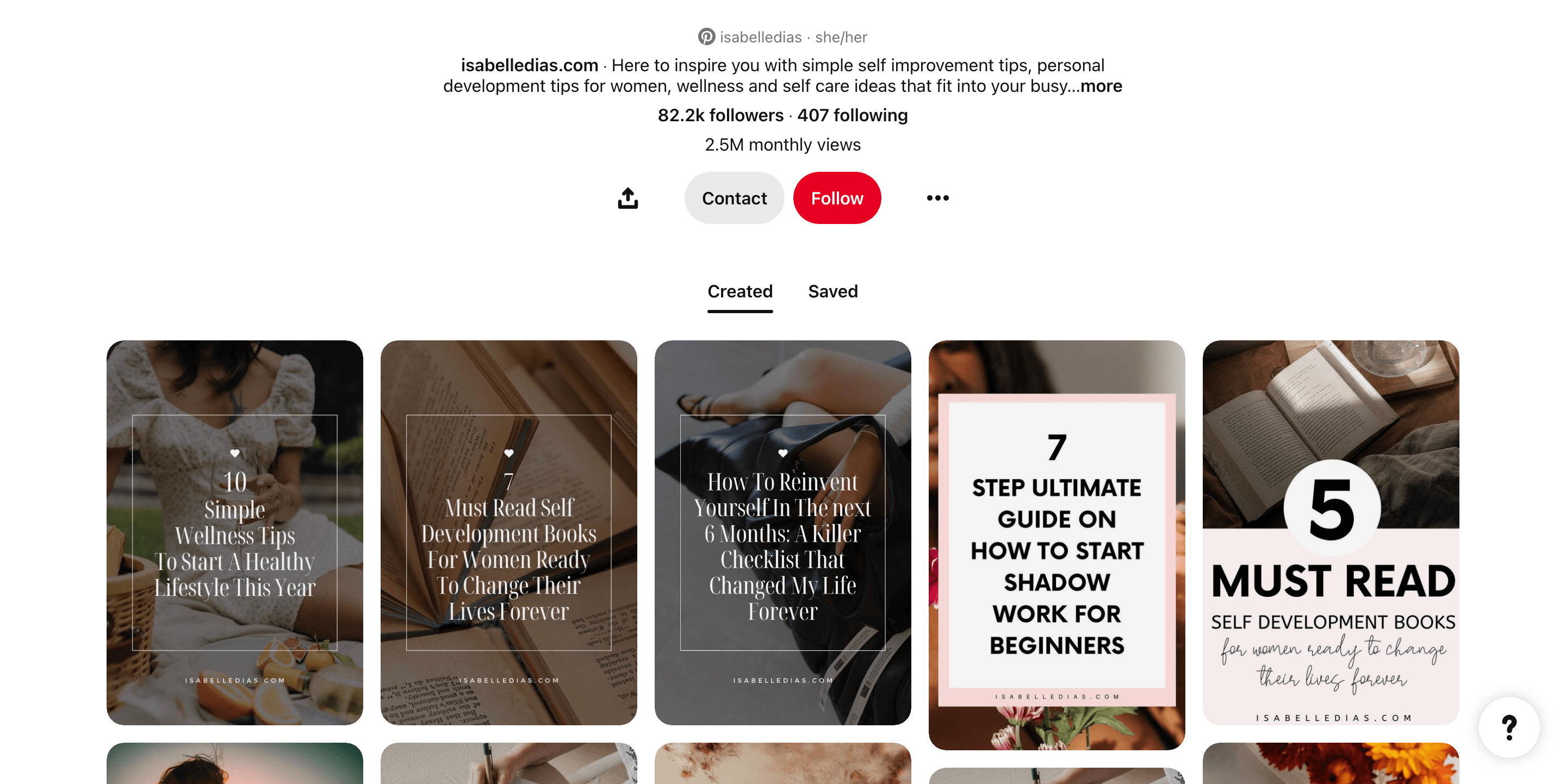
Certain types of content perform best in specific formats. For example, videos are great for in-depth tutorials, while images are excellent for aspirational fashion inspiration. That said, you can be flexible in choosing content formats and exercising your creativity.
⚠️ Note: Don’t compromise on the quality of your Pinterest pins to meet a certain number. Pinterest content has a longer shelf life — meaning the pins you create today can generate traffic for weeks. Invest time in creating thoughtful, quality content that is actually relevant to your target audience.
Now, creating and posting even five pins per day on a regular basis sounds exhausting. Who has the time to write the title, description and edit posts every single day? The solution: Batch create content and schedule pins using Buffer. You can create pins in advance and queue them into relevant boards.
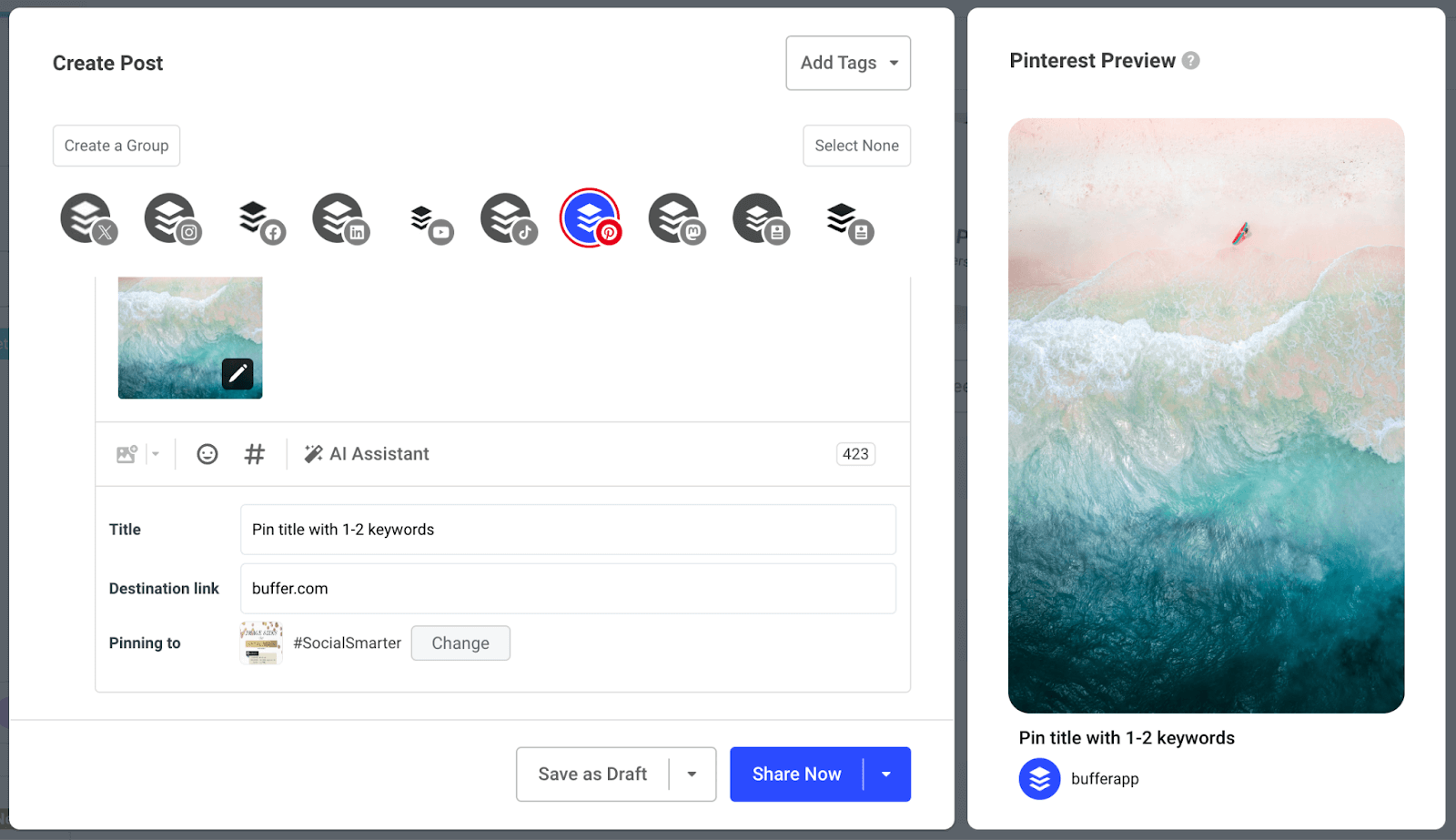
The best part? If you add a destination link, Buffer will automatically pull through the available images on your website. So, if you’re adding Pinterest-worthy photos on your website already, you don’t even need to upload the image if you use Buffer.
5: Publish high-quality vertical images & videos
Pinterest is a visual platform. High-quality matters on Pinterest — whether it’s for infographics or videos. The ideal image size is 1000 x 1500 pixels in a 2:3 aspect ratio. Pinterest says other ratios can negatively impact your performance because the image’s text is half-visible. The ratio is also ideal because most Pinterest users use the app on their mobile.
A great example is Melisza Mcfierce’s Pinterest profile. Each and every pin she posts is of extremely high-quality and stands out as clean, clear, and crisp on the home feed.

6: Select a strong cover image for your pins
When Pinterest users hunt for something in the search bar, they click on the pin with the most appealing cover image. Pinterest agrees: They recommend thinking strategically about the cover image and its text.
This tip is important because the Pinterest algorithm can scan your images and understand whether or not they match your pin description and overall profile niche. So, your Pinterest cover images should contextualize what you’re discussing in the pin.
Let’s say you’re a travel creator and are creating a pin on the best coworking cafes in Prague. Don’t use a sunset as the cover image for this pin — use a relevant cafe’s image instead.
When I type “best coworking cafes in Prague” in the Pinterest search bar, it displays all the relevant images of cafes (with relevant overlay text!) at the top.

7: Use Pinterest boards to organize your Pins
Pinterest boards are a way to categorize your various content pillars into different folders. This advice comes straight from Pinterest.
“Because we know pinners are planners, it’s important to focus on your board strategy.”
Pinterest also suggests keeping your board names straightforward instead of clever to make them SEO-friendly. For example, if you’re creating a board about makeup recommendations, name your board something simple and direct, such as “Makeup products recommendations,” instead of using an informal term such as “makeup products that slap.”
The fashNcurious Pinterest profile is an A+ example. The mother-daughter duo creates fashion content on Pinterest and organizes it in boards such as “nail content” and “fashion inspiration for all occasions.”
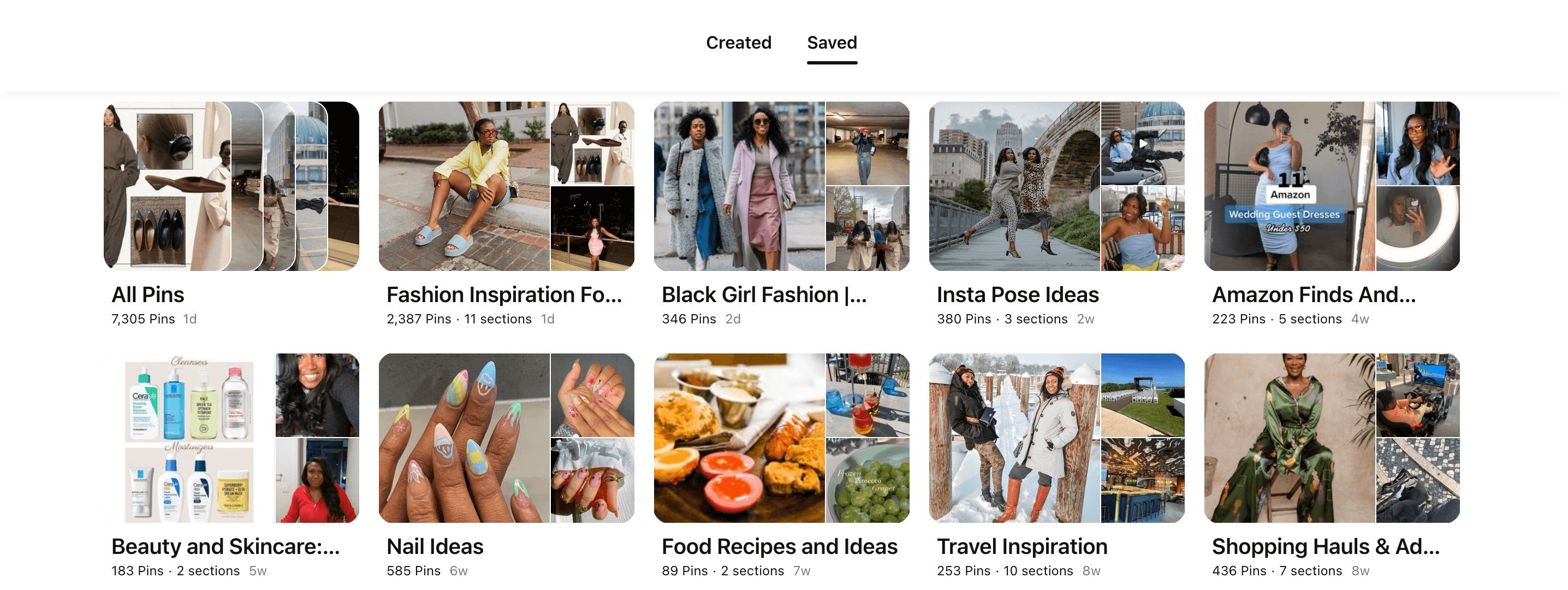
Categorizing your content into boards also helps new followers navigate your profile and get similar content in one window. Here’s how to create a board:
1. Go to your Pinterest profile
2. Click on “Saved”
3. Click on the “➕” plus icon on the right-hand side
4. Choose “Board”
5. Name your board and start pinning pins to it
If you want to take it up a notch, you can also create sections within your boards. For example, if one of your Pinterest boards is about “winter recipes,” you can bifurcate it further into sections like “winter beverages” or “winter desserts.”
8: Add a call-to-action (CTA) to every pin
What should your target audience do after they come across a pin from you? Adding a call-to-action to every pin you create ensures your audience takes that next step of following you or visiting your website. For example, in this pin, fitness creator Jacquelyn has a clear CTA to watch her YouTube video.

Some other call-to-action phrases you can use:
1. Read the full blog on my website
2. Follow me for more [your niche] content
3. Save this for later
4. What do you think of [topic of your pin]?
5. Comment your favorite [something relevant to your pin] below
You can also add a voiceover for your CTA if you share a video on Pinterest.
9: Engage with others
If I had a penny for every time I saw a creator posting and ghosting on Pinterest, I’d be swimming in cash. Social media marketing is a two-way street. This is especially true for Pinterest. It encourages active users to respond to comments, pin frequently, and share ideas with each other.
If you want to grow on Pinterest, you have to build a community. This means following others in your niche, commenting on other people’s content, and responding to comments & direct messages (DMs) you receive. For example, Suman replies to questions and comments on her Pinterest videos to help her audience.
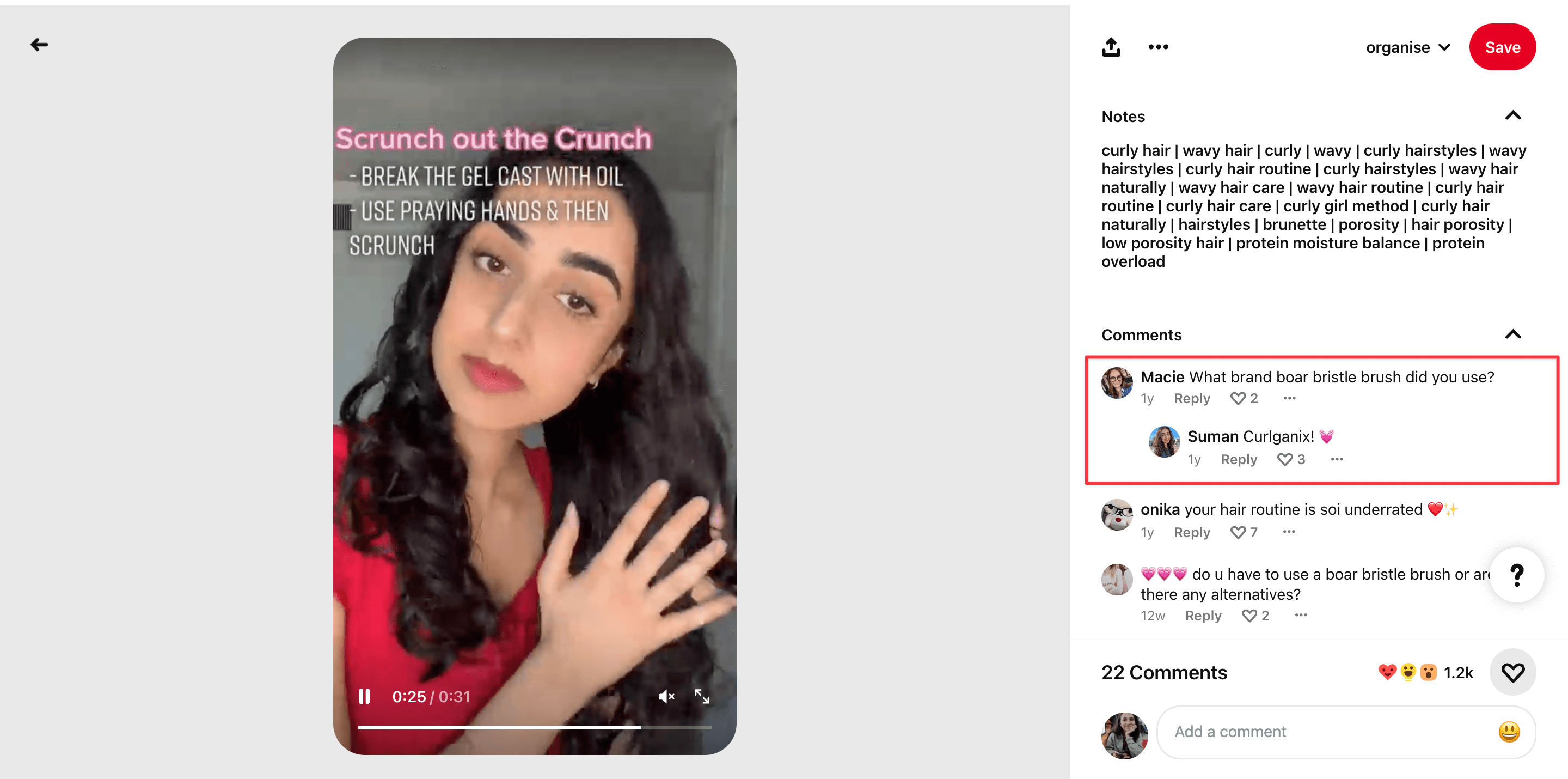
Engaging on Pinterest doesn’t have to be complicated! Take out 10–20 minutes every day to respond to any notifications you receive. When you reply to someone, you increase engagement and also prompt them to check your pin again. Also scroll Pinterest for the kind of content you like. If you find another creator in a relevant niche with useful content, follow them and engage with their profile. They might follow you back or start saving your pins on their board.
10: Join relevant group boards
Group boards are Pinterest boards with multiple collaborators. You can create your own group board by inviting collaborators and giving them various levels of permissions.
There are popular group boards in every niche that aid in providing an additional reach to your Pinterest content. You can request to join these boards and participate in pinning content consistently. Use pingroupie to search for popular group boards in your niche. Most group boards will also use the description to share guidelines on joining the board and set up some ground rules.
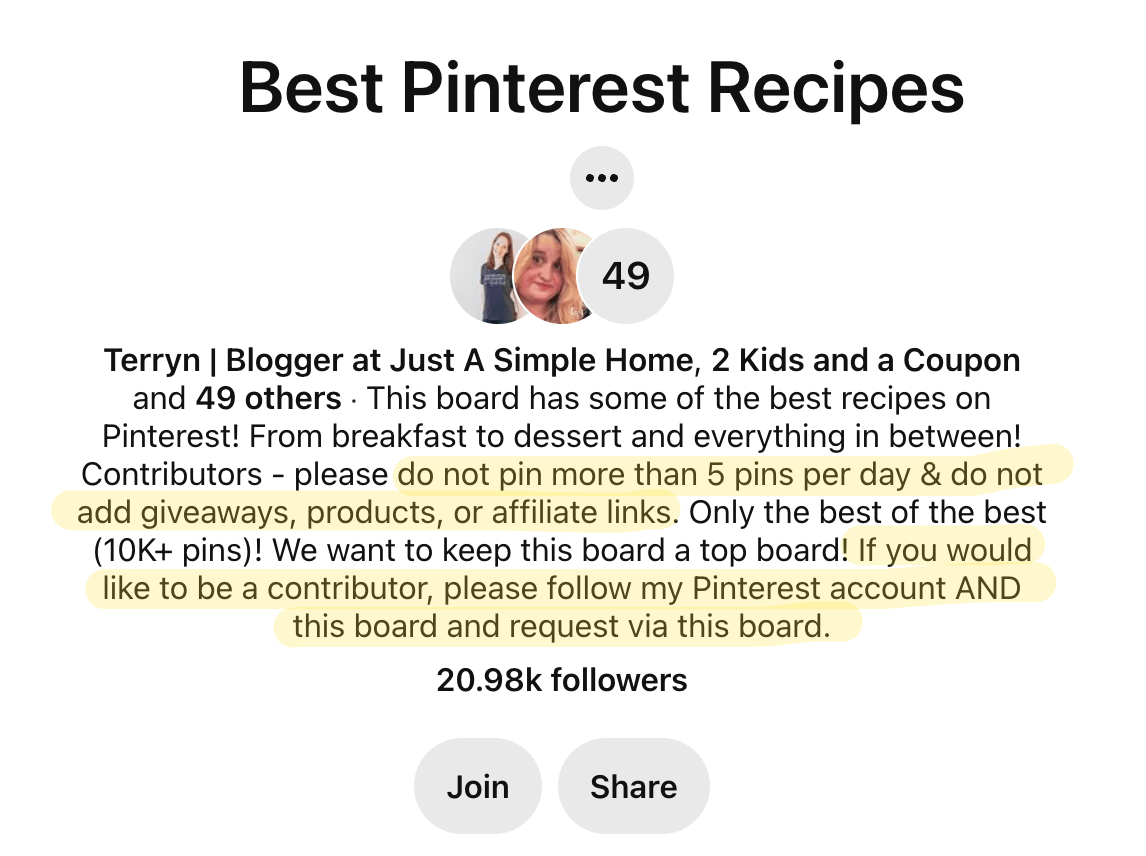
11: Tailor your repurposed content to the Pinterest platform
Since the Pinterest algorithm scans your image content for contextual cues, it’s crucial that you do the editing of your content within the platform.
So, for example, if you’re repurposing a TikTok video for Pinterest, remove the accompanying text and add Pinterest’s text instead. Use the platform’s native editing abilities as much as possible to publish more Pinterest-friendly content — and boost your follower count by extension.
12: Level-up your content using music, duration settings, stickers, and more
Pinterest has developed a ton of native editing features — like editing music, syncing text to video, adding stickers, and more. Use all of these features to create more engaging content.
Academia Central Fitness is an excellent example of how to use Pinterest’s various features to create scroll-stopping pins. They align the text to the videos they share, use Pinterest’s native font, and add stickers & music to all their pins.
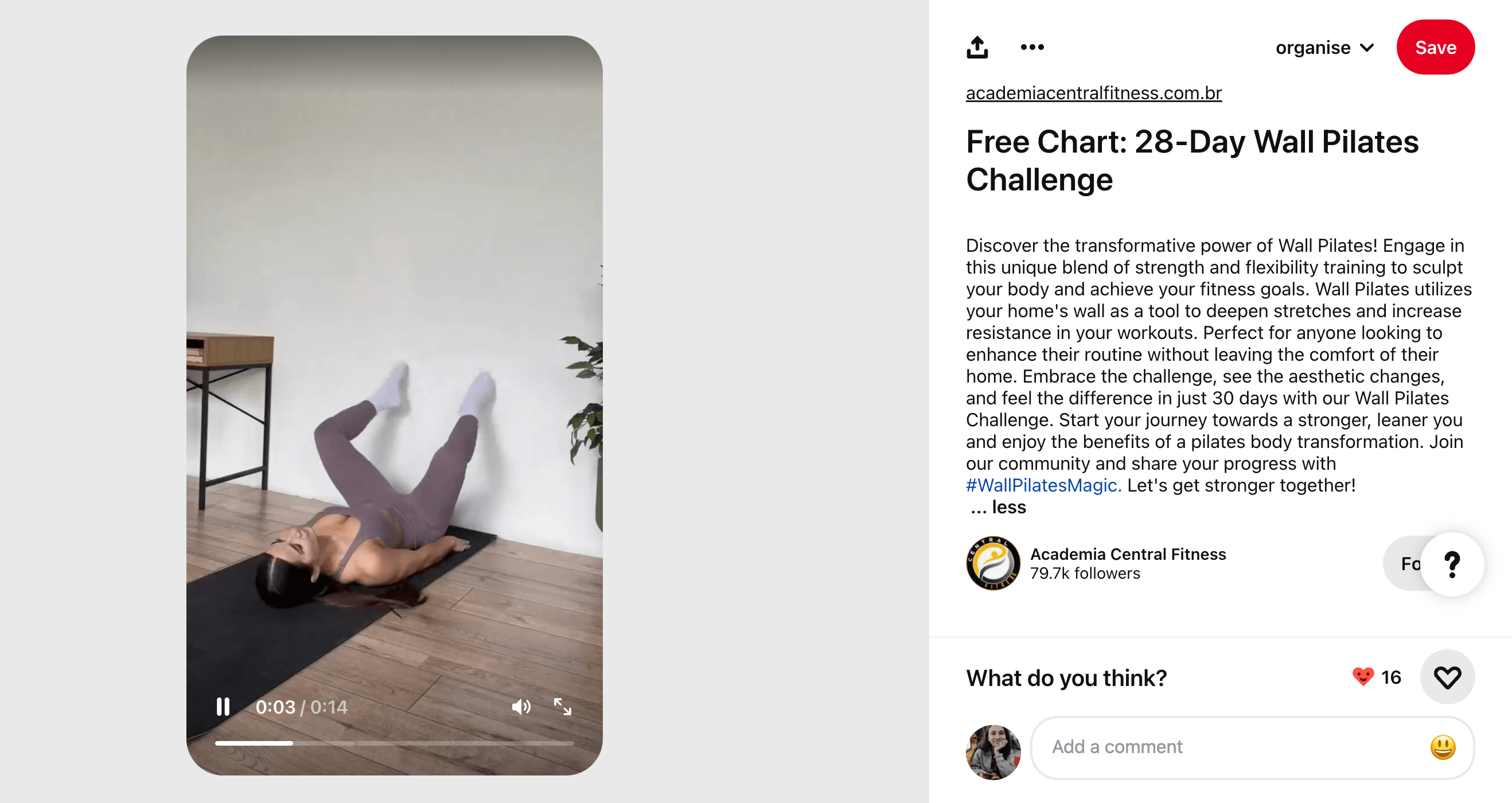
13: Optimize your images, pin descriptions, and text overlays for SEO
If you pick the right keywords on Pinterest, you’ll improve your discoverability and increase your number of followers. Pinterest also highlights that using the right keywords for SEO positively affects the distribution of your content.
Use keywords in three spaces on Pinterest:
- Text overlays
- Title
- Pin description
⚠️ Note: In text overlays, ensure your image is as easy to read as possible. Remember people are scrolling on their phones. Small fonts are easy to miss. Use header fonts to show what your image is about.
This pin by Cassey Ho of Blogilates on “how to do a split” is an excellent example of how to sprinkle keywords into your Pinterest content.
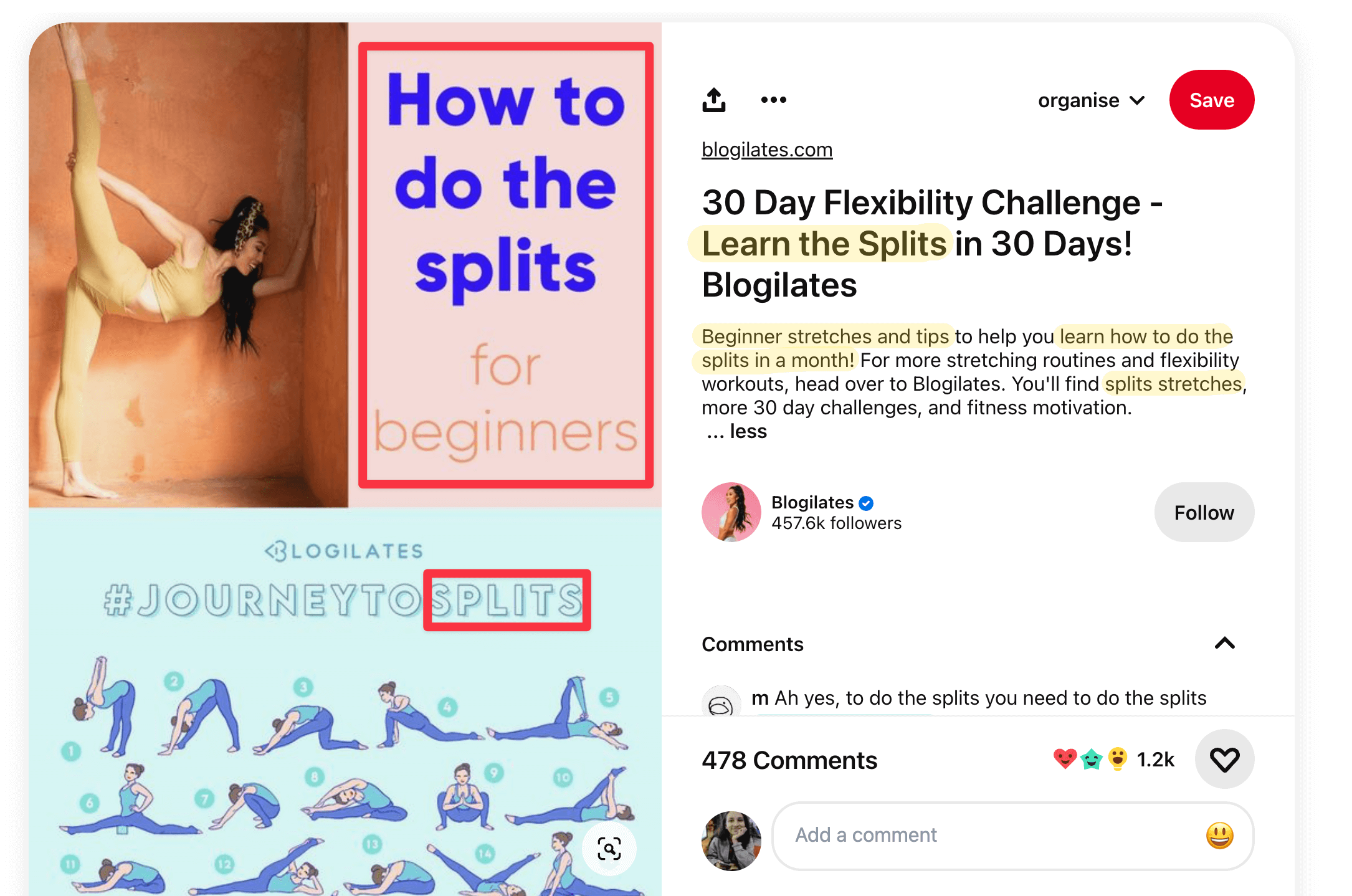
How do you find relevant keywords related to your pin? You can search for your topic on Pinterest, see the suggested keywords that pop up, and monitor what your competitors are using. You can also use the Pinterest trends tool to search for your topic and find what your audience is searching for.
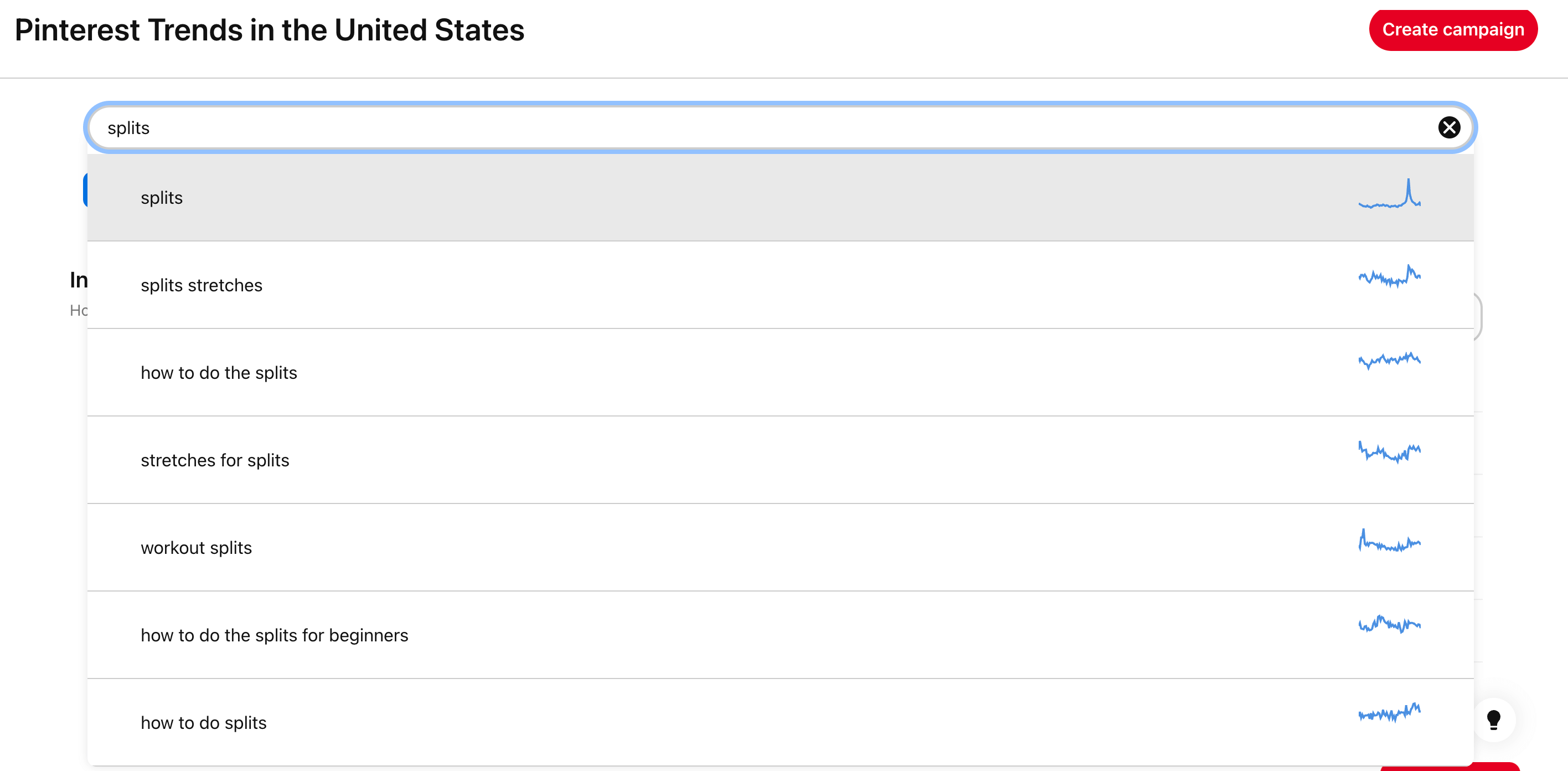
14: Use topic tags instead of hashtags
Topic tags are the new hashtags on Pinterest. Although you might still see many creators using hashtags, Pinterest says they rely on topic tags to categorize your content.
You can add up to 10 topic tags for each pin you post. Pinterest gives you the option to “tag related topics” while you’re posting your pin.
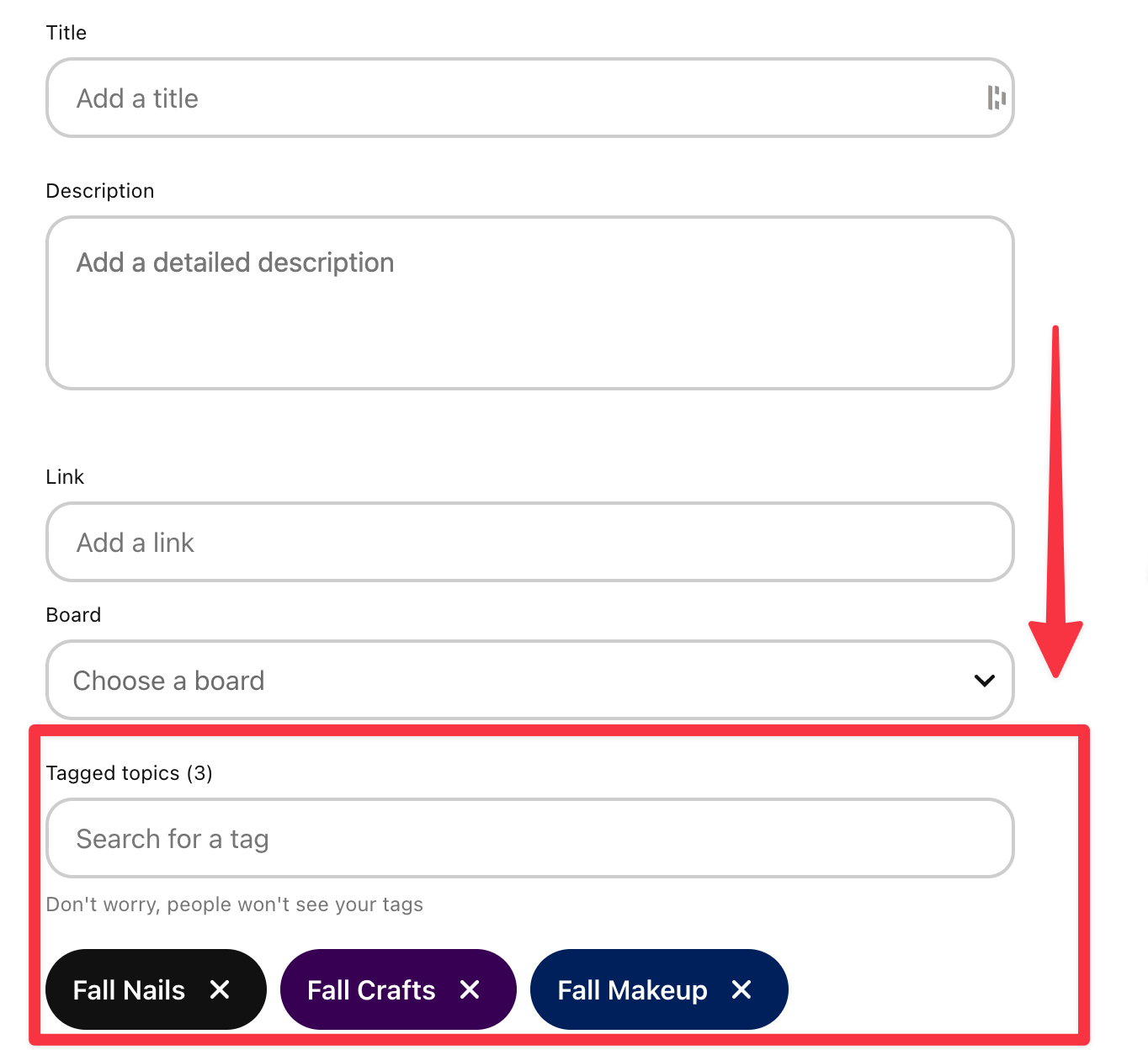
Pinterest users can’t see your tagged topics — which is another benefit since it doesn’t appear spammy like hashtags.
15: Create content your audience would want to save
The Pinterest algorithm prioritizes content that’s saved. In their own words:
“If there’s a Pin with a lot of saves, the system will recommend it across the platform’s main pages over other less inspiring, less engaging content.”
A save signals to Pinterest that your post has meaningful engagement and that people resonate with your idea. Ask yourself: “What kind of content would my target audience want to bookmark?” and create more and more of it.
Creating savable content should be your top Pinterest marketing strategy. People often return to the saved content — increasing your engagement even further.
16: Hop on trending content
Pinterest users love seasonal content more than any other social media platform. And Pinterest capitalizes on it by giving you tons of resources to find the latest trends on the social network:
3. A Pinterest predicts series to help you ace future trends today
4. A theme to organize your content for the whole year and inspire your content calendar
Use these resources to create trending content in advance (as much as possible). Some trends — like the holidays — allow you to prepare pins early because you know that spike is coming.
17: Use Pinterest analytics to guide your content strategy
Once you switch to a business account, you get in-depth insights into how your content is performing. You get details like saves, outbound clicks, pin clicks, profile visits, and more. Which metrics are the most important depends on your goals. For example, if you want to grow website traffic via Pinterest, the outbound click rate is the most important.
Spend some time each week or month identifying your best-performing pins. Maybe you noticed how-to video content gets the highest number of saves and click-through rates, so you can double down on it when you start creating new pins.
18: Craft multiple pins for the same post
Shreya Dalela used Pinterest to grow the website Elite Content Marketer’s traffic by a whopping 829 percent (!) in just three months. One of her top tips is creating multiple pin designs for the same topic. For example, she suggested varying the designs for the same header or splitting one long-form post into mini infographics.
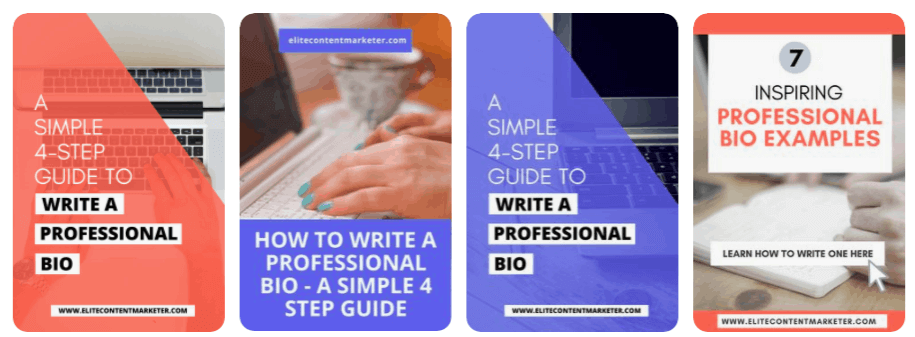
This is an excellent way to get the most out of every piece of content you create and also an A+ Pinterest strategy to pin more without burning yourself out. But it comes with two caveats:
- Shreya suggests avoiding pinning multiple posts with the same URL in one day, as this might come across as spam. Instead, spread it out over a few days or weeks.
- Shreya also recommends first testing how five pins on one topic perform. If it performs well, create more pins for it. If not, don’t design more pins for it.
19: Promote your pins
If you have some budget for Pinterest ads, consider promoting your Pinterest pins to reach potential followers. How to create a Pinterest ad?
1. Click on the three horizontal lines at the top left corner of your Pinterest profile
2. Click on “Promote a Pin”
3. Set a goal and a destination URL for your pin
4. Set a daily budget for your ad
5. Choose the audience you want to target
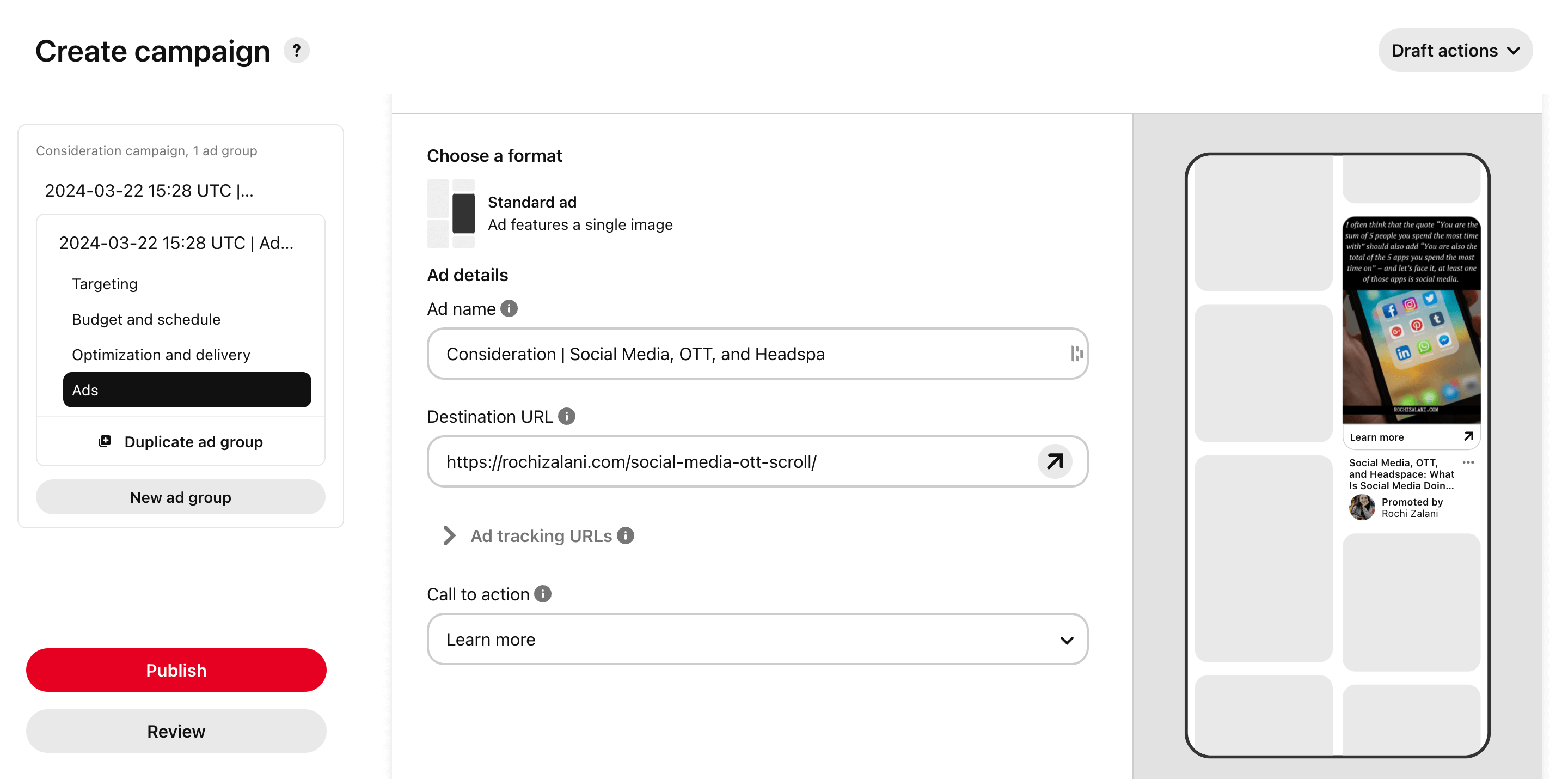
And you’re done!
While we’re fans of organic growth here at Buffer, giving your pins a little nudge (if you can afford to) hurt no one. Try Pinterest ads for yourself and see if promoted pins give you enough return-on-investment (ROI) to become a regular part of your Pinterest marketing strategy.
20: Add a Pinterest follow button to your website, newsletter, and other social media
Last but not least: Encourage the followers, fans, and email subscribers you already have to follow you on Pinterest. In your email newsletter or Instagram Stories, you can share a regular “What we’re pinning” update to remind your existing followers to check you out on Pinterest, too.
For example, at Buffer, we link our Pinterest profile to the footnote of our website — along with other social accounts.
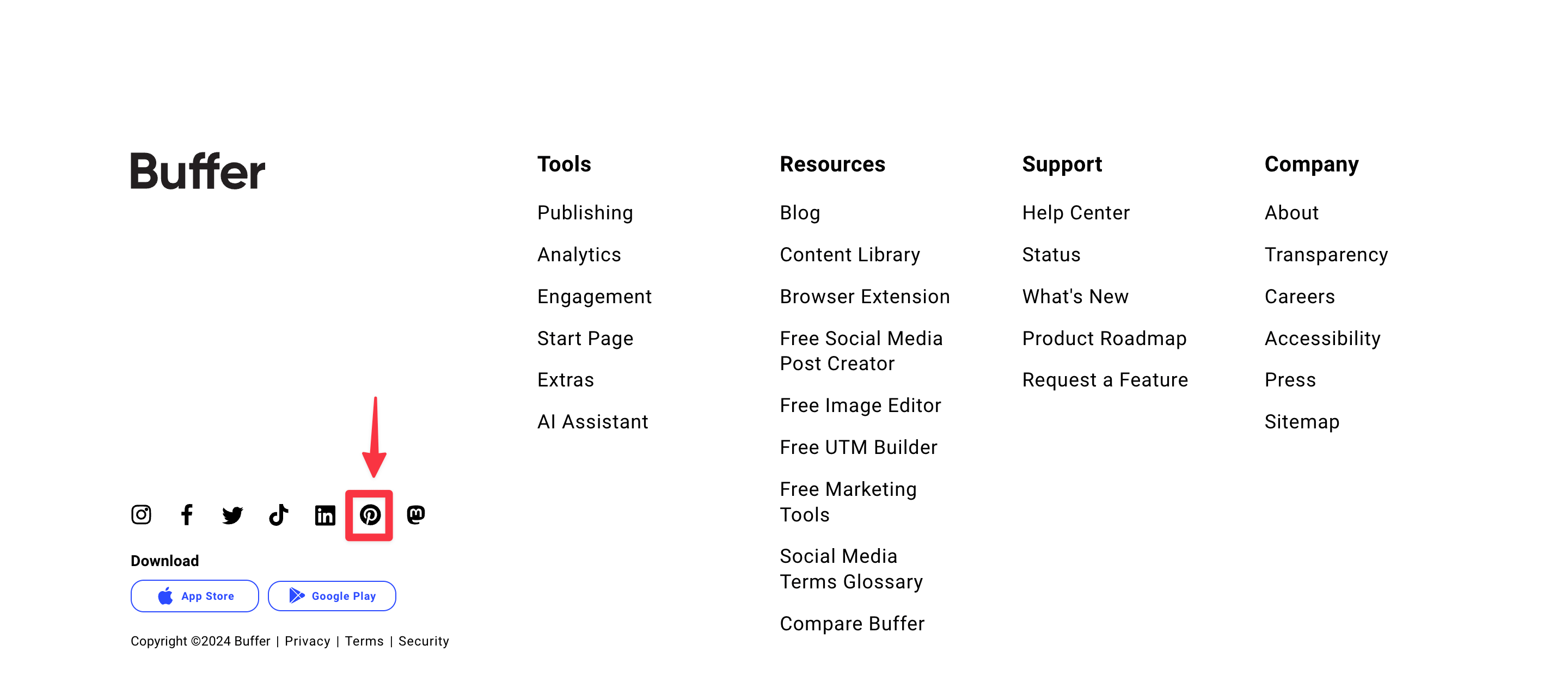
But remember: Your target audience needs a reason to follow you on Pinterest. Perhaps you create a bait of exclusive content or all your existing content organized neatly into boards & sections your audience can refer back to easily. Whatever it is, craft a compelling offer that’d entice people to click the follow button.
There’s more to Pinterest than Pinterest followers
Pinterest is known as the social network to drive more traffic to your website. It encourages its users to go away from the platform to create — an anomaly in the social media marketing world.
So, while Pinterest followers are a good metric to evaluate your growth on Pinterest, remember it’s not the only one. If you’re getting decent traffic, enough saves & impressions, and engaged comments, you’re doing Pinterest right! Don’t focus on gaining new Pinterest followers in a silo — look at the big picture and focus on building a community on the platform.
Read more: Pinterest Idea Pins: The complete guide to inspiring your followers and How to use Pinterest Marketing to Gain Exposure for Your Small Business



